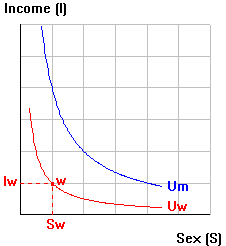Sex or Money: It's All in the Cards
Dr. Joyce Brothers, Los Angeles Times, November 28, 1991.
DEAR DR. BROTHERS: My wife and I are happily married,
with no major problems that I'm aware of. But recently I've noticed some male-female
differences.
We have a two-career family and both of us enjoy a weekly poker game,
mine is with the boys, and my wife plays with women from her office.
When the guys talk, we usually joke or talk about sex--but not the
ladies.
I eavesdrop and their conversation centers around money and shopping.
Does this mean anything?
--W.D.
DEAR W.D.: I'm not sure, but your observations seem to correspond to a
poll of 2,491 adults, all of whom described themselves as the main financial
decision-makers.
The poll was conducted by Money magazine. About 63% of these
respondents were men; 37% were women.
About 51% of the women polled confessed that they think about money
more often than sex, in contrast to only 27% of the men, whose eye and thoughts were on
the dollar.
The real eye-opener from this poll was that nearly one-third of the
women reported that they enjoy money more than sex; a mere 26% favored sex.
Of the males, only 16% put money first, while 47% gave sex the top
priority.
[A:] This may be related, in part, to the fact that males
almost always make more money, and they usually have more cash in their pockets.
 Suppose
heterosexual men (m) and women (w) have similar preferences for sex and income. Women
consume typical bundle "w" on Uw, while men consume along Um because of their
higher income. Um is simply Uw drawn to a larger scale. The horizontal axis measures the
amount of (conventional) heterosexual sex engaged in by men and women.
Suppose
heterosexual men (m) and women (w) have similar preferences for sex and income. Women
consume typical bundle "w" on Uw, while men consume along Um because of their
higher income. Um is simply Uw drawn to a larger scale. The horizontal axis measures the
amount of (conventional) heterosexual sex engaged in by men and women.
1. Draw the MRS at point w.
2. Use an "m" to indicate on Um the corresponding typical
consumption bundle for men, and draw the MRS at point m.
3. Does the analysis here support or contradict the interpretation of
the evidence offered by Dr. Brothers in the last paragraph (passage A) of the article?
Explain.
 Suppose
heterosexual men (m) and women (w) have similar preferences for sex and income. Women
consume typical bundle "w" on Uw, while men consume along Um because of their
higher income. Um is simply Uw drawn to a larger scale. The horizontal axis measures the
amount of (conventional) heterosexual sex engaged in by men and women.
Suppose
heterosexual men (m) and women (w) have similar preferences for sex and income. Women
consume typical bundle "w" on Uw, while men consume along Um because of their
higher income. Um is simply Uw drawn to a larger scale. The horizontal axis measures the
amount of (conventional) heterosexual sex engaged in by men and women.